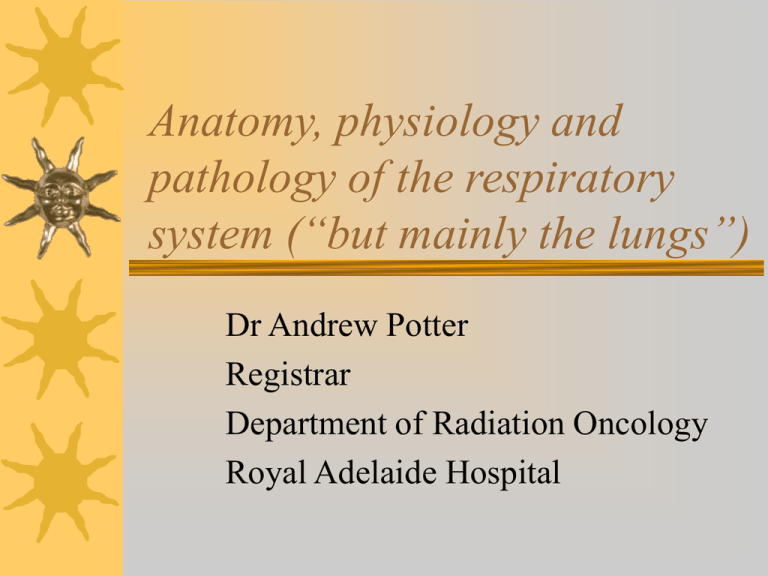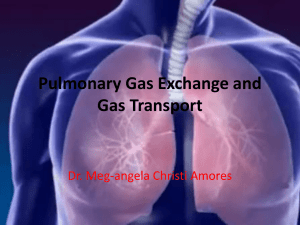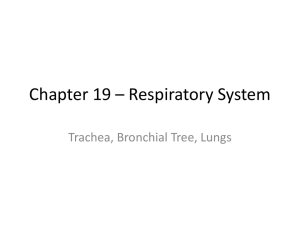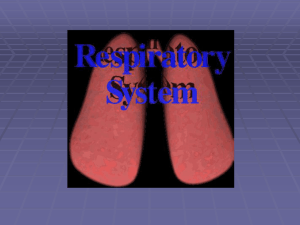
Anatomy, physiology and
pathology of the respiratory
system (“but mainly the lungs”)
Dr Andrew Potter
Registrar
Department of Radiation Oncology
Royal Adelaide Hospital
Anatomy
Overview
Consists of nose, pharynx, larynx, trachea,
bronchi, lungs
Conducting portion and respiratory portion
Obtains O2 and eliminates CO2 to external
environment
Helps regulate pH by adjusting rate of
removal of acid-forming CO2
Nose
External portion
– Bone and cartilage, covered by skin
– Mucous membrane lining
– Nostrils, midline septum
Internal portion
– Skull cavity inferior to cranium, superior to mouth
• Bounded by ethmoids, maxillae, palatine bone, inferior nasal
conchae
– Communicates with pharynx through the choanae
– Communicates with paranasal sinuses
• frontal, sphenoid, maxillary, ethmoid
– Openings of naso-lacrimal ducts, Eustachian tubes
Pharynx (throat)
Funnel-shaped tube, ~13cm long
Starts at choanae (internal nares) extending
to level of cricoid cartilage
Posterior to nasal cavity, oral cavity, larynx
Anterior to cervical vertebral bodies
Muscular wall lined by mucous membrane
Nasopharynx
Uppermost part of pharynx
Posterior to nasal cavity
Extends to plane of soft palate
Eustachian tube openings
– Allows air exchange to equalise
ear/nose/throat pressures
Pharyngeal tonsils (adenoids) on post wall
Oropharynx
Posterior to oral cavity
Extends from soft palate to level of hyoid
Common passage way for air, food, fluid -
communicates with oral cavity
Palatine and lingual tonsils
Hypopharynx (laryngopharynx)
Extends downwards from hyoid
Continuous with oesophagus (posteriorly)
and larynx (anteriorly)
Common passage way for air and food
Larynx (voice box)
Connects pharynx with trachea
Epiglottis
– cartilage valve to separate food and air
Midline in neck, anterior to C4-C6
Wall consists of 9 pieces of cartilage
– 3 single
• Thyroid, epiglottis and cricoid
– 3 paired
• Arytenoid, corniculate, cuneiform
Vocal cords - false (ventricular) and true
– Vibration of vocal cords results in phonation
– Barrier against foreign bodies entering lower respiratory tract
Upper respiratory tract summary
System of interconnected spaces
Transports, filters, humidifies and warms
inspired air
Receptors for smell in the nasal cavity
Paranasal sinuses act as resonating
chambers for speech
– Also reduce weight of facial skeleton
Trachea
Tubular air passage way ~12cm long,
2.5cm diameter
Anterior to oesophagus
Extends from larynx (cricoid cartilage) to
~T5
Bifurcation at T5 (carina) into left and
right main bronchi
Trachea
16-20 incomplete ‘C’-shaped hyaline
cartilage rings provide rigidity
– Open part of each ring faces posteriorly to
oesophagus
– Allows for oesophageal expansion during
swallowing
Transverse smooth muscle (trachealis) and
elastic connective tissue attach open ends
of cartilage rings
Trachea
Important relations
– Anteriorly: thyroid isthmus, inferior thyroid
veins, sternohyoid and sternothyroid muscles,
manubrium, thymus remnants
– Laterally: lobe of thyroid, carotid sheath, SVC
(right), aortic arch and branches (left),
– Posteriorly: oesophagus, recurrent laryngeal
nerves
Trachea
Ciliated pseudo-stratified
columnar epithelium
Seromucous glands and
ducts
– humidify air
Cilia (‘brush border’)
– Transport excess mucus,
foreign bodies upwards
like an escalator
Primary (main) bronchi
Incomplete cartilage rings
Stratified columnar epithelium as in trachea
Right main bronchus
– To right lung
– Shorter, wider and more vertical than left
• More prone to foreign bodies lodging
Left main bronchus
– To left lung
Secondary (lobar) bronchi
One for each lobe of each lung
– 2 on the left
– 3 on the right
Further division into tertiary (segmental) bronchi
to supply each segment of each lobe
…progressive branching until reaching
bronchioles and finally terminal bronchioles and
alveolar ducts
Structural features
Gradual transition from one type of airway
to the next
Epithelium
– Tall, pseudostratified columnar ciliated
epithelium in larynx and trachea
– Simple cuboidal non-ciliated in small airways
– Goblet cells (mucus secreting) gradually
disappear
Structural features
Lymphoid aggregates (MALT)
– Produces IgA antibodies secreted onto mucosal
surface
• protection against invading micro-organisms
Smooth muscle
– Lies deep to mucosa (except in trachea)
– Becomes increasingly important as airway diameter
decreases
– Regulates calibre of airway and hence resistance to air
flow
• Sympathetic - muscle relaxation
• Parasympathetic - constriction
Structural features
Serous and mucous glands
– Progressively less numerous in narrower
airways
Cartilage
– Supporting skeleton for larynx, trachea and
bronchi
– Maintains patency during respiration
– Gradually diminishes; absent beyond tertiary
bronchi
Lungs - gross anatomy
Paired, cone-shaped organs in thoracic cavity
Separated by heart and other mediastinal
structures
Covered by pleura
–
–
–
–
Fibrous membrane with overlying flattened epithelium
Outer layer - parietal pleura, attached to chest wall
Inner layer - visceral pleural, attached to lung surface
Potential space between the two layers (pleural
cavity)
• Normally contains small amount of pleural fluid - reduces
friction between surfaces during movement of respiration
Lungs - gross anatomy
Extend from diaphragm inferiorly to just above
clavicles superiorly
Lies against thoracic cage (pleura, muscles, ribs)
anteriorly, laterally and posteriorly
Inferior lung base is concave and fits over
convexity of each hemi-diaphragm
Narrow superior apex
Surface curved to match curvature of rib cage
Lungs - gross anatomy
Hilum
– Medial ‘root’ of the lung
– Point at which vessels, airways and lymphatics
enter and exit
Cardiac notch
– Lies in medial part of left lung to
accommodate the heart
Lobes and fissures
Lungs divided into lobes by fissures
– Both have an oblique fissure extending forwards and
downwards
• Separates upper and lower lobes on left
• Separates upper, middle and lower lobes on right
– Right lung also has horizontal fissure
• Separates upper and middle lobes
Each lobe has its own secondary (lobar) bronchus
– Named according to the lobe supplied
Further subdivision of each lobe into segments
– …similarly supplied by a tertiary (segmental)
bronchus
Lobules
Each segment has multiple small
compartments - lobules
– Each wrapped in connective tissue
– Contains lymphatic vessel, arteriole, venule,
branch from terminal bronchiole
– Terminal bronchioles subdivide into
microscopic respiratory bronchioles
Alveoli
Cup-shaped outpouchings
Clustered in alveolar sacs
– Resemble microscopic bunches of grapes
Lined by epithelium
Thin elastic basement membrane
Lined by type I alveolar cells with occasional
type II alveolar cells
– Type II cells secrete alveolar fluid and surfactant
– Surfactant acts to reduce surface tension of alveolar
fluid (like detergent), helping to keep alveoli from
snapping shut
Alveoli
Alveolar macrophages (dust cells)
– Phagocytes that remove dust and debris from
alveolar spaces
– Derived from peripheral blood monocytes
Alveoli surrounded by capillary network to
facilitate gas exchange
– Single layer of endothelium and basement
membrane
Alveolar-capillary membrane
Diffusion of gas between air and circulation
occurs across alveolar and capillary walls
–
–
–
–
Type I and II alveolar cells
Epithelial basement membrane beneath alveolar wall
Capillary basement membrane
Capillary endothelium
Total thickness ~0.5µm
Approx 300 million alveoli in normal lung
Results in large surface area (~70m2) for gas
exchange
Alveoli
Alveoli - micro
Lung - blood supply
Dual supply
– Bronchial supply
• Bronchial arteries supply bronchi, airway airway walls and
pleura
– Pulmonary supply
• Pulmonary arteries enter at hila and branch with airways
• Deoxygenated blood from right ventricle pulmonary trunk
left and right pulmonary arteries arterioles
capillaries oxygenated blood to venules pulmonary
veins left atrium
– Venous return is common (ie. both return via
pulmonary veins)
Lymphatics
Lymphatic drainage follows vessels
Parabronchial (peribronchial) lymphatics
and nodes hilar nodes mediastinal
nodes pre- and para-tracheal nodes
supraclavicular nodes
Physiology
Mechanics of breathing
Inspiration - an active process
– Diaphragm lowers
– Ribs pivot upwards
• Intercostal muscles contract
• Action similar to a swinging bucket handle
– Intra-thoracic pressure lowers
• Intrapleural pressure is normally 4mmHg lower than
atmospheric pressure, ‘sucking’ the lungs outwards
– Lung expands
• As volume increases, pressure decreases - Boyle’s law
– Air flows from higher atmospheric pressure
(760mmHg) into low pressure of the lungs
(758mmHg)
Mechanics of breathing
Expiration - passive
– Inspiratory muscles relax
• Ribs move downwards
• Diaphragm relaxes and its domes rise
– Surface tension of alveolar fluid causes an inward pull
– Elastic recoil of alveolar basement membranes
– Reverse pressure gradient
• 762mmHg in lungs, 760mmHg atmospheric
– Gas pushed out
Respiration
External (pulmonary) respiration
– exchange of O2 and CO2 between respiratory
surfaces and the blood (breathing)
Internal respiration
– exchange of O2 and CO2 between the blood and
cells
Cellular respiration
– process by which cells use O2 to produce ATP
External respiration
Exchange of O2 and CO2 between alveoli and
blood
Partial pressure of O2 higher in alveoli
(105mmHg) than blood (40mmHg) so O2
diffuses into blood
Partial pressure of CO2 higher in blood
(45mmHg) than alveoli (40mmHg), so CO2
moves into alveoli in opposite direction and
gets exhaled out
Gas partial pressures
Gas
Atmospheric
air
Alveolar air
Exhaled air
O2
21%
159 mmHg
14%
104 mmHg
16%
120 mmHg
N2
78%
597 mmHg
75%
569 mmHg
75%
566 mmHg
CO2
0.04%
0.3 mmHg
5%
40 mmHg
4%
27 mmHg
H2O
0.5%
4 mmHg
6%
47 mmHg
6%
47 mmHg
Internal respiration
Exchange of O2 and CO2 between blood and
tissues
Pressure of O2 higher in blood than tissues so O2
gets release into tissues.
Pressure of CO2 higher in tissue than in blood so
CO2 diffused in opposite direction into blood.
CO2 is a waste product
O2 is used in cellular respiration
Pulmonary respiration
Internal respiration
Gas transport in blood
Carbon dioxide
– 70% as bicarbonate ion (HCO3-) dissolved in
plasma
– 23% bound to hemoglobin
– 7% as CO2 dissolved in plasma
Oxygen
– 99% bound to hemoglobin
– 1% as O2 dissolved in plasma
Control of breathing
Respiratory centre in reticular formation of
the brain stem
– Medullary rhythmicity centre
• Controls basic rhythm of respiration
• Inspiratory (predominantly active) and expiratory
(usually inactive in quiet respiration) neurones
• Drives muscles of respiration
– Pneumotaxic area
• Inhibits inspiratory area
– Apneustic area
• Stimulates inspiratory area, prolonging inspiration
Regulation of respiratory centre
Chemical regulation
– Most important
– Central and peripheral chemoreceptors
– Most important factor is CO2 (and pH)
• in arterial CO2 causes in acidity of
cerebrospinal fluid (CSF)
• in CSF acidity is detected by pH sensors in
medulla
• medulla rate and depth of breathing
Regulation of respiratory centre
Cerebral cortex
– Voluntary regulation of breathing
Inflation reflex
– Stretch receptors in walls of
bronchi/bronchioles
Pathology
Benign pathology
Infective
– URTI, pneumonia, bronchitis, bronchiectasis
– Bacterial, viral, fungal
Vascular
– Pulmonary emboli, vasculitis, pulmonary oedema
Traumatic
– Pneumothorax, haemothorax
Inflammatory
– Idiopathic pulmonary fibrosis, sarcoidosis
Environmental
– Silicosis, asbestosis
Genetic/congenital
– Cystic fibrosis
Asthma
Reversible airways obstruction
Common (10% children, 5% adults)
Recurrent wheeze and breathlessness
Multiple triggers
– Allergy, infection, cold, exertion, irritation,
drugs, occupational exposure
Complex chronic inflammation of
bronchial mucosa
Chronic obstructive airways
disease (COAD, COPD)
Combination of chronic bronchitis and
emphysema
– Chronic inflammation of bronchi
• Chronic cough with sputum
– Destruction of normal alveolar structure
• Loss of inhibition of proteases (esp. 1-antitrypsin)
• Reduced surface area for gas exchange - fewer,
large dilated air spaces
• Relative hypoxia, worse on exertion
Neoplastic diseases of the lung
Common cancer
Peak incidence 40-70 years of age
Closely related to cigarette smoking and
industrial carcinogens
4 main histological types
–
–
–
–
Squamous cell carcinoma (SCC) - 50%
Small cell carcinoma (SCLCa) - 20%
Adenocarcinoma - 20%
Large cell anaplastic carcinoma (LCLCa) - 10%
Neoplastic diseases of the lung
Commonly grouped as small cell (SCLCa)
and non-small cell (NSCLCa) based on
natural history and response to treatment
70% arise in relation to main bronchi
30% arise from peripheral airways or
alveoli
Lung cancer
Squamous cell carcinoma
– Arises in metaplastic squamous epithelium that
develops to line airways against chronic exposure to
irritants such as smoke
– More common in men but women catching up
– Mostly central/close to carina
Adenocarcinoma
–
–
–
–
Tend to be peripherally located
Less closely associated with smoking
Equal sex distribution
4 sub-types
• Acinar, papillary, solid, bronchoalveolar
Lung cancer - gross appearance
Central squamous cell
carcinoma arising
near right main
bronchus
Peripheral
adenocarcinoma
Lung cancer
Small cell carcinoma
–
–
–
–
Highly malignant
Centrally located
Rapidly growing
Neuro-endocrine properties and behaviours
• eg. SIADH
– Commonly present with metastatic disease
– Often chemo- and radio-sensitive and
responsive but rarely curable
Lung cancer - presentation
Respiratory features
– Cough (80%), haemoptysis (70%), dyspnoea (60%),
chest pain (40%), wheeze (15%)
Systemic features
– Anorexia, weight loss, malaise
70% present with metastatic disease
– Local spread - bronchus, mediastinum
– Lymphatic spread - peribronchial, hilar nodes
– Trans-coelomic spread - malignant effusion, chest
wall invasion
– Haematogenous spread - brain, bone, liver, adrenal
glands
Lung cancer - prognosis
Poor 5-year survival
– (5-30% depending on type and stage at
presentation)
NSCLCa
– 75% inoperable due to age, poor lung function
or advanced stage (CT head/chest/abdo, PET,
WBBS, mediastinoscopy)
– If inoperable, consider chemo-radiotherapy
(radical or palliative depending on stage)
Lung cancer - prognosis
SCLCa
– ~30% are ‘limited stage’ (confined to within
an achievable RT field)
• Good local control with chemoRT but usually
progress to systemic disease
• Role of PCI
• Median survival 11 months
• 45% 1-year survival
– Extensive stage
• Palliation only
Malignant mesothelioma
Primary neoplasm of pleura
Closely related to asbestos
exposure
Latent period of up to 50
years
Chest pain, breathlessness
Forms a thick rind around
lung and pericardium
Death usually occurs within
10 months
No effective treatment
RT to prevent spread along
biopsy/drain tracks as
needed
Respiratory system - summary
Upper respiratory tract
– Series of cavities to filter, warm, humidify and
conduct air to lower respiratory tract
Lower respiratory tract
– Trachea, bronchial tree deliver air to alveoli
– Gas exchange within alveoli
• Diffusion down partial pressure gradients
– Dual blood supply
• Unique features of pulmonary circulation
– Mechanics of breathing
Respiratory system - summary
Lungs
– Paired thoracic organs
– Facilitate gas exchange
– Differences between left and right
Pathology
– Huge range of benign conditions
– Neoplastic disease
•
•
•
•
SCLCa
NSCLCa - SCC, adenoca, LCLCa
Mesothelioma
Poor prognosis
“The real reason dinosaurs
became extinct…”











